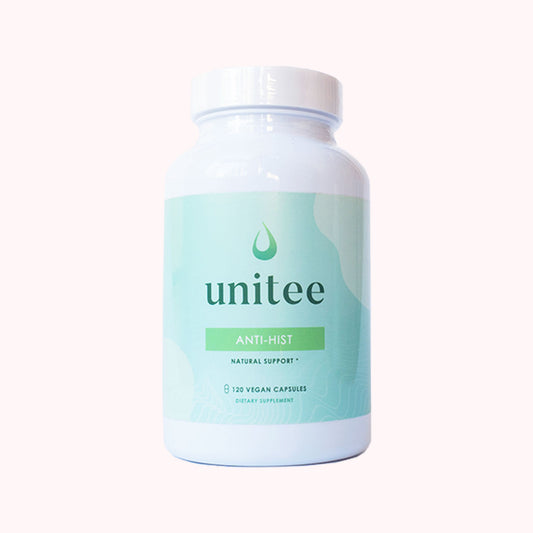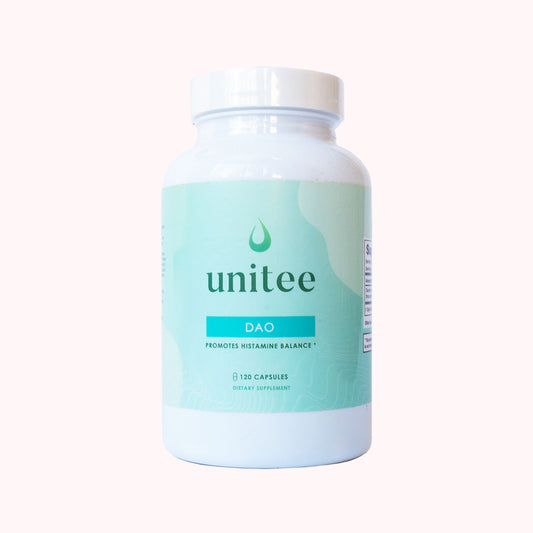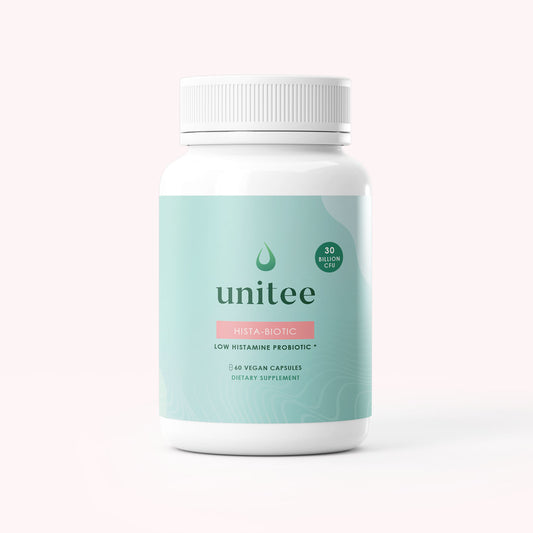Are you wondering if a histamine intolerance could be linked to your headaches and migraines?
By now you’re likely quite familiar with what histamine intolerance is and the symptoms it may cause.
After reading about the symptoms of histamine intolerance, you can probably understand why you get hives and skin rashes as a result of histamines being released into the skin.
But... why would histamine intolerance be associated with such severe brain splitting headaches?
Especially since the brain itself does not contain pain receptors, and is unable to feel pain? The answer might surprise you…
Migraine headaches and histamine intolerance
While the brain doesn’t have pain receptors itself, the protective layers of tissue that surround the brain sure do.
When we look at the mechanisms of headaches, they typically occur as a result of an increase in blood flow to the blood vessels located around and within these tissues, which cause pressure that activates the pain receptors they contain.
These headaches, because of the effect on the vasculature, or blood vessels, are called vascular headaches.
So, what does this have to do with histamine intolerance?
Think about what you already know about what happens to the skin when you have a histamine reaction: it becomes red and swollen, in addition to the itching.
The reason for the swelling is an increase in fluid being deposited as a result of the heightened histamine load. And, now you know that an increase in fluid causes vascular headaches, so put the two together and you’ll quickly realise that an increase in histamine within the brain and its surrounding tissues can increase the pressure, which causes the pain (1).
Histamine compounds commonly deposit in these brain tissues as they are rich in the histamine H3 and H4 receptors. The rich histamine receptor distribution in the brain means that histamines form an essential part of neurological health, but it’s the excess that causes all of the problems (2).
The headaches are usually associated with pain in one location or multiple sites across the head, and it all depends on the receptors that are being activated.
When you have a headache along with tearing of the eyes, nasal congestion and/or runny nose, facial sweating and/or a sense of agitation, it’s usually a histamine-related headache.
Now that you know why histamine excess causes headaches and how you can distinguish between another type of headache, the next question is: what do you do to stop these terrible headaches (and other symptoms associated with them)?
Are migraines typically caused by histamine intolerance?
It is common for individuals with histamine intolerance to experience migraine headaches as a symptom.
However, migraine headaches can be caused by a variety of other issues, as well.
An example includes hormonal imbalances such as low estrogen levels that occur pre-menstruation or in perimenopause, while another example includes alcohol abuse.
As you can see, the range of causes for migraine headaches can be quite varied.
It is important that you address the underlying cause of your migraines, as the long term effects if left untreated can be highly negative.
The long term effects of untreated migraines include sensory issues such as light sensitivity, psychological issues such as anxiety, depression and panic attacks, and cardiovascular issues such as hypertension and even stroke.
The issue of migraines is much more significant than just a headache, so it's incredibly important to figure out the root cause, which is why investigating if histamine intolerance is causing your migraine headaches is of key importance.
Histamine intolerance is often under-recognized and awareness of the issue is still developing across healthcare practitioners. So, if you have been searching for the cause of your migraine headaches to no avail, histamine intolerance could be the key to figuring out this equation!
The silver lining here is that, if you do suspect a histamine intolerance, it is relatively easy to test for and even easier to experience symptom reduction in a relatively short period of time.
There are several steps you can do at home to test for histamine intolerance, however the first step in identifying if you're histamine intolerant involves eliminating high histamine foods with a low histamine diet to see if your symptoms improve.
Improve headaches and migraines with a low histamine diet
Reducing the amount of histamine that the body contains is the very first step to improving histamine-related migraine headaches.
As you already know, one of the easiest ways to do so with relatively easy implementation is to follow a low histamine diet. Reducing the amount of histamine in your food, reducing the amount of histamine your body releases as a result of food, and improving the production of diamine oxidase enzymes (the enzymes that degrade histamine) all comes with eating a low histamine diet.
To get the list of all of the allowed and restricted foods on the low histamine diet and a full guide for reducing symptoms, click below:
This brings me to the second step: increasing histamine breakdown with diamine oxidase (DAO) enzymes.
DAO, as you know, is diamine oxidase, which is the primary enzyme your body uses to break histamine down. Research shows that many people who experience migraines are actually deficient in this enzyme (3).
In fact, around 90% of people who experience severe and debilitating migraines were found to have a deficiency in the ability to produce and maintain adequate levels of DAO (4).
Along with an increase in histamines in food, and/or an increase in the production/release of histamines by the body, there is an overload of histamines in the body, they flood to the brain and cause those terrible headaches we’ve been talking about. Taking a DAO supplement, which has been used in some European countries as an innovative approach to migraine treatment, is in its early stages of regulation, but the results are promising (4).
If you, like so many others with histamine intolerance, simply can’t get rid of those bothersome headaches, put your focus on your diet as a start, as each meal provides an opportunity to improve your health and symptoms. Here is a handy low histamine food list that can help to get you started.
Remember that histamine intolerance is not a primary condition, meaning that it does not simply occur on its own. While you’re trying to manage your symptoms, keep looking for the underlying cause of your histamine intolerance. You can read more in this article about all things histamine intolerance.
3 supplements to improve histamine-associated migraine headaches
As we have discussed, there are several interventions that can improve histamine-associated migraine headaches.
Taking the correct supplements involves finding out the underlying cause of your histamine intolerance - however, there are 3 supplements that are quite standard for those experiencing histamine intolerance as they target the foundation of histamine intolerance root causes.
Keep in mind, these supplements should be taken alongside a low histamine diet and it is ideal to use a histamine intolerance intervention plan in order to identify and fully heal your unique issues at a pace that's compatible with your body.
Below, I'll list the top 3 supplements and how each of them are helpful and relevant for the issue of histamine intolerance and histamine-associated migraine headaches.
1. Diamine oxidase enzymes (DAO) - These are the enzymes responsible for degrading ingested histamine and reducing high histamine levels in the gut. As mentioned above, 90% of people who experience severe and debilitating migraines were found to have a deficiency in the ability to produce and maintain adequate levels of diamine oxidase enzymes (4).
This statistic is incredibly important because diamine oxidase deficiencies can occur for a variety of reasons, including a genetic inability to produce adequate amounts of DAO. By supplementing with diamine oxidase enzymes to replace those that are missing, histamine levels can start to appropriately break down, therefore eliminating histamine intolerance symptoms including histamine-associated migraines.
2. Anti-hist - This is an all-natural antihistamine which operates by stabilizing mast cells. Mast cell activation syndrome is an underlying cause of histamine intolerance that has shown to be associated with migraine headaches as a symptom.
When mast cells are destabilized or over-activated, they release more histamine than is normal and the body cannot keep up with breaking it down as fast as it is being released. This issue causes a buildup of histamine and therefore produces symptoms such as migraines.
By using a mast cell stabilizer, histamine release can become more regulated, therefore preventing high histamine symptoms such as migraine headaches.
3. Low histamine probiotics - As is becoming increasingly known, gut health provides the foundation for overall health. The bacteria in our bodies are involved, either directly or indirectly, in every single process within the body. One of these processes include the production of histamine!
Bacteria naturally produce histamine through the conversion of the amino acid histidine into histamine. If your body is functioning normally, this production is not an issue and is a natural process. However, if you are experiencing issues such as low levels of DAO, mast cell activation syndrome or, simply too high of a level of histamine-producing bacteria, then this causes issues that result in a buildup of histamine which therefore produces histamine intolerance symptoms.
In order to support your gut health but reduce the histamine load on your body, it is important to take low histamine probiotics, which are actually incredibly hard to find. As mentioned, most probiotics will naturally produce histamine, so taking any random probiotics off the shelf - even if they are working well for loads of other people with different issues - could majorly mess your symptoms when it comes to histamine intolerance.
Histamine intolerance is its own ballgame, and a lot of gut health interventions can make symptoms worse, so balancing your intestinal ecosystem out by introducing probiotics that only contain anti-histamine or histamine neutral bacteria is essential.
By supporting your gut with low histamine probiotics, you are supporting the improvement of your histamine intolerance and any associated symptoms such as migraine headaches.
References:
- Worm, J., Falkenberg, K. & Olesen, J. Histamine and migraine revisited: mechanisms and possible drug targets. J Headache Pain 20, 30 (2019).
- Alstadhaug, K.B. (2014), Histamine in Migraine and Brain. Headache: The Journal of Head and Face Pain, 54: 246-259.
- Izquierdo-Casas J, Comas-Basté O, Latorre-Moratalla ML, Lorente-Gascón M, Duelo A, Vidal-Carou MC, Soler-Singla L. Low serum diamine oxidase (DAO) activity levels in patients with migraine. J Physiol Biochem. 2018 Feb;74(1):93-99.
- Izquierdo-Casas J, Comas-Basté O, Latorre-Moratalla ML, Lorente-Gascón M, Duelo A, Soler-Singla L, Vidal-Carou MC. Diamine oxidase (DAO) supplement reduces headache in episodic migraine patients with DAO deficiency: A randomized double-blind trial. Clin Nutr. 2019 Feb;38(1):152-158.

Anita Tee
My name is Anita Tee. I'm a nutritional scientist who specializes in histamine intolerance. I hold a Master of Science in Personalized Nutrition and a Bachelor of Science in Human Biology and Psychology.For the past ten years, I have used my experience in nutritional and medical health sciences to create a scientifically backed, natural approach to healthcare that relies 100% on evidence-based research.As I previously suffered from - and overcame - histamine intolerance, my focus is to increase recognition and expand the available resources and protocols available for resolving this particular disorder. To date, I have helped over 4,000 individuals fully resolve or better manage their histamine intolerance symptoms.







